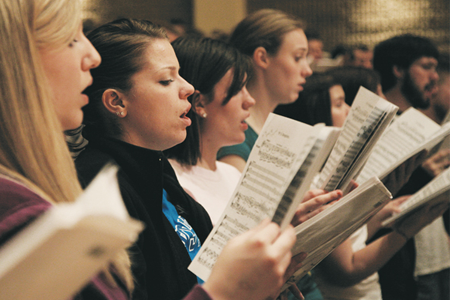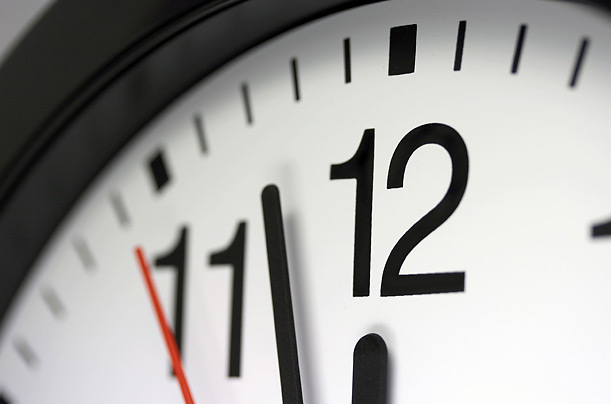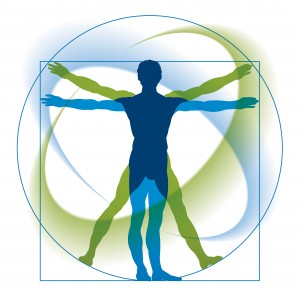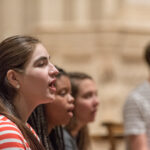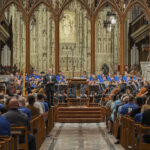Introduction
If a student or parent in your church asked you if you would give private voice lessons, how would you respond? Would you be enthusiastic, reserved, hesitant or even nervous at the thought? Your answer might be dictated according to availability within your already hectic schedule, but my assumption is that many would respond with hesitancy because of a perceived lack of “expertise.”
As I come out of my “cone of silence” on CueWeb, I thought I would bring to our online community a series of articles on the voice. It is natural for me to bring these topics here at this specific time because I am teaching a class entitled “Choral Techniques” where we deal with the various issues related to working with choirs. Currently, we are in a unit on vocal fundamentals. Now, I must say that I do not consider myself an expert vocal pedagogue. I do not teach private voice at Lee; I simply enjoy vocal pedagogy (the study of teaching voice), and it spurs me on to continually investigate ways to incorporate sound vocal teaching into the choral rehearsal.
Many are probably already thinking, “I don’t have time to teach voice in rehearsal; I have one rehearsal a week plus I haven’t a lot of private voice study.” Fear not, for behold I bring you good tidings of great joy…”
The truth is that a little bit of vocal fundamental teaching, when consistently applied and reinforced week after week, will yield great dividends.
For those that are familiar with my choral warm-ups, I will use a similar pattern/progression in this series on the voice. We will deal with each aspect of the singing process in individual articles. For instance:
-
Prepare the body
-
Activate the breath
- Respiration
-
Engage the voice
- Phonation
- Resonation
- Articulation
- Tune the ear
-
Awaken the mind
In each installment, we will establish appropriate and fundamental technique and examine common problems, causes, and solutions. Now, let’s get to it.
Prepare the Body
First, let’s make sure our singers have engaged their bodies for singing. As most of you know, adolescents have a lot of energy—especially when in large groups. (It’s like they feed off of each other!) So why not use that energy to your advantage, especially as you start rehearsal each week?
#1 – Get them moving.
- Rub hands/pat legs, snap, etc. (to help focus) & have them MIRROR you while you do this.
- Clap at 4 corners in front of you; alternating which side you move to; randomly stop to see who is watching.
- Stretch up & down, massage shoulders, shake arms & legs, roll shoulders & neck.
- Shoulder massage train (both directions; use musical dynamic and expression terms for styles of massage, i.e., staccato, legato, piano, forte, marcato, etc.).
- Have singers lock eyes on the director (YOU) and point their nose at director’s moving finger.
#2 – Here are some exercises for engaging individual aspects of good technique for the body.
The majority of this material comes from a great resource that you should get: The Choral Challenge by Michael Kemp. I’ve supplemented it with a few of my own ideas. Don’t be afraid to pull from just a few of these things. Certainly don’t try to do them all in one rehearsal. Remember: Keep these exercises moving—one after another—with a lot of energy and enthusiasm in your instructions and demonstrations.
Torso
- Pull elbows
- Turn torso
- Roll shoulders
- Hug yourself
- Reach way up, one hand at a time. Feet flat on the floor. (Stretches lower back)
- Move tummy in & out; “ho-ho-ho” exercises (use hee, heh, ha)
Neck
- Drop head forward – shake like “no-no” motion
- Twist head to left and then to right
- Left ear to left shoulder; right ear to right shoulder
- Pretend there is a flashlight coming out from the top of head and draw circles and loops on the ceiling
- Exhale and drop head down – move slowly from side to side
- Tilt head forward and back, and gentle pull to L & R with opposite hand.
Face, lips, jaw
- Massage the jaw line and neck muscles
- Stretch or move muscles in face, brow; head wiggle
- Scrunch face to nose; open face wide away from nose
- Massage temples; whole face
- Alter lip positions – “ooh” vs “ee”
- Massage masseter muscles (muscles that bulge in jaw when teeth are clinched)
#3 – With the body active, awake, and engaged, it’s important to establish good posture.
So why is good posture necessary? In short, it helps the body function at maximum efficiency.
- Descriptors for posture: COMFORTABLE & ALERT (positive, aggressive, involved, and aware)
- Good posture is NOT getting in a “fixed” position. It’s about a dynamic relationship between flexibility and balance; continuous movement toward lengthening and balance.
- Continually monitor and remind students of the appropriate posture.
- Standing posture
- Feet as tripods (base of big, little toe, and center of the heel)
- Imagine heels aimed down into the floor
- Knees unlocked; flexible as if about to sit
- Top of spine leads the posture; not sternum (which puts chest too far out)
- Aim spine towards ceiling; lengthen the spine (like accordion on its side)
- Ask the students to feel their vertebrate separating as they stand tall
- Imagine pulling a string out of the top of the head
- Sitting posture
- Sit forward on edge of chair
- No ribs on backs of chairs
- Body weight resting on sitz bones
Take 1-minute rehearsal breaks to check alignment lengthening and positioning.
We will continue next time with fundamentals of breathing for singing.


